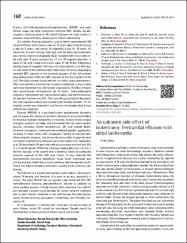| dc.contributor.author | Güler, Ekrem | |
| dc.contributor.author | Güler, Gamze Babür | |
| dc.contributor.author | Yavuz, Cahit | |
| dc.contributor.author | Kızılırmak, Filiz | |
| dc.date.accessioned | 10.07.201910:49:13 | |
| dc.date.accessioned | 2019-07-10T19:36:05Z | |
| dc.date.available | 10.07.201910:49:14 | |
| dc.date.available | 2019-07-10T19:36:05Z | |
| dc.date.issued | 2015 | en_US |
| dc.identifier.citation | Güler, E., Güler, G.,B., Yavuz, C. ve Kızılırmak, F. (2015) An unknown side effect of isotretinoin: Pericardial effusion with atrial tachycardia. Anatolian Journal of Cardiology, 15(2), 168-169. https://dx.doi.org/10.5152/akd.2015.5790 | en_US |
| dc.identifier.issn | 1302-8723 | |
| dc.identifier.uri | https://hdl.handle.net/20.500.12511/1056 | |
| dc.identifier.uri | https://dx.doi.org/10.5152/akd.2015.5790 | |
| dc.description.abstract | acne vulgaris and other dermatologic disorders. Systemic isotretinoin therapy may cause some cardiac side effects, like atrial tachycardia (1), congenital heart disease, and cardiac remodeling (2), reported as case reports. A 26-year-old female presented to the emergency unit of with syncope after a long palpitation episode. Her physical examination was normal except for tachycardia. A 12-lead electrocardiogram revealed atrial tachycardia, and the heart rate was 149 beats/min. After a 25-mg intravenous injection of diltiazem hydrochloride bolus, the atrial tachycardia terminated and normal sinus rhythm was sustained. Her laboratory tests and chest X-ray were normal. Echocardiography revealed normal left ventricular function and pericardial effusion of 0.8 cm at posterior side, 0.9 cm at the right atrial side and 1.3 cm at the right ventricle side. Several atrial tachycardia episodes were detected on rhythm Holter. During the longest episode of atrial tachycardia, the heart rate was 149 beats/min. The patient had been on oral isotretinoin therapy of 0.5 mg/kg/day for the previous 4 months because of nodular acne and was not using any other medication. After consulting with a dermatology physician, isotretinoin was stopped. Holter analysis revealed whole-day sinus rhythm 2 months after the drug therapy was interrupted. Echocardiography revealed gradual regression of pericardial effusion at the follow-up. | en_US |
| dc.language.iso | eng | en_US |
| dc.publisher | Turkish Society of Cardiology | en_US |
| dc.rights | info:eu-repo/semantics/openAccess | en_US |
| dc.subject | Isotretinoin | en_US |
| dc.subject | Pericardial | en_US |
| dc.subject | Tachycardia | en_US |
| dc.title | An unknown side effect of isotretinoin: Pericardial effusion with atrial tachycardia | en_US |
| dc.type | letter | en_US |
| dc.relation.ispartof | Anatolian Journal of Cardiology | en_US |
| dc.department | İstanbul Medipol Üniversitesi, Tıp Fakültesi, Dahili Tıp Bilimleri Bölümü, Kardiyoloji Ana Bilim Dalı | en_US |
| dc.authorid | 0000-0002-4607-5724 | en_US |
| dc.authorid | 0000-0003-1919-3183 | en_US |
| dc.identifier.volume | 15 | en_US |
| dc.identifier.issue | 2 | en_US |
| dc.identifier.startpage | 168 | en_US |
| dc.identifier.endpage | 169 | en_US |
| dc.relation.publicationcategory | Diğer | en_US |
| dc.identifier.doi | 10.5152/akd.2015.5790 | en_US |
| dc.identifier.wosquality | Q4 | en_US |


















